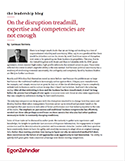On the Disruption Treadmill, Expertise and Competencies are Not Enough
There is no longer much doubt that we are living and working in a time of unprecedented volatility and uncertainty. Who, say, in 2013 predicted that there would be driverless cars on the streets by 2016? And these waves of disruption now seem to be spreading out from business to geopolitics. This year, first in the United Kingdom with Brexit and then in Colombia with the FARC peace agreement, voters rejected high-stakes, high-profile referenda that seemed certain to pass. Those votes rejected the extent to which unpredictability is the new normal. And because political uncertainty has a tendency of reinforcing economic uncertainty, the ambiguity and complexity faced by business leaders are likely to further accelerate.
Boards and CEOs thus find themselves tested as never before—not because the problems are so large but because the traditional toolbox is increasingly useless against them. A legacy auto manufacturer, for example, can’t simply restructure or grow its way out of the rise of ridesharing. It has to completely rethink both its business and its culture in ways that it hasn’t had to before. And here’s the sobering reality: After all that rethinking is done and the business has been transformed, it won’t be long before the process has to begin all over again to counter some new threat or seize some opportunity that was completely unforeseen during the last transformation.
The only way companies can keep pace with this disruption treadmill is to change how they assess and develop leaders. Most talent management functions are set up to reward and promote based on the assumption that past success is indicative of future performance and that industry expertise is the coin of the realm. The emphasis on past success and traditional business competencies has selectively weeded out those who perhaps scored lower on those metrics but who also had other qualities necessary to thrive in constantly changing conditions.
Some of those traits we’ve discussed in earlier posts: the curiosity to gather new experiences and knowledge, the insight to synthesize vast amounts of disparate information, the engagement to inspire connection and the determination to persevere and to surmount obstacles. Leaders with these qualities have consistently shown to have the agility and creativity necessary to adapt when an original strategy fails. Rather than wasting precious time trying to figure out why an outmoded method fell short, these executives see the failure of old approaches as an opportunity to lead innovation. The ability to quickly shift gears gives them a material advantage over slower-moving competitors.
Organizations also must place greater weight on having a sense of purpose—the ability to see a role and an organization in terms of contributing to society and improving the lives of the end user, instead of merely meeting performance targets and strategic goals. Until recently, thinking about “purpose” was left to non-profit organizations. But it turns out that having that larger context and connection is essential for any entity hoping to transform itself. (See our white paper, “A New Leadership Paradigm for Successful Organizational Transformation.”) Because purpose is forward-focused, it reinforces the agility needed to respond to unforeseen developments. And not only is purpose strategy- independent, but it continues to be a relevant guidepost even after disruption has rendered strategy ineffective. The importance of purpose will only grow as millennials—who as a group are driven by connection and purpose—rise up through the ranks at work and dominate the economy at home.
Placing greater emphasis on qualities like curiosity and sense of purpose will require talent management functions to evaluate executives over a longer time horizon; the return on personal behavior cannot always be measured in neat quarterly intervals. But organizations that make the investment in identifying and developing leaders tailored for the disruption treadmill will find it far easier to adapt to the uncertainty and complexity that define the business environment today.






